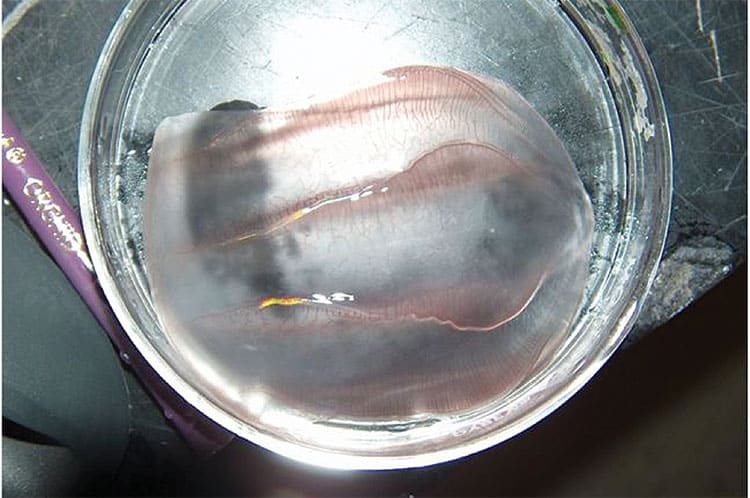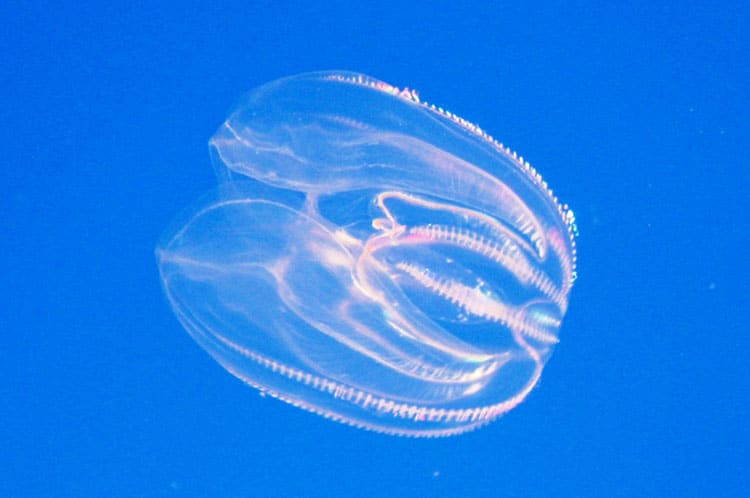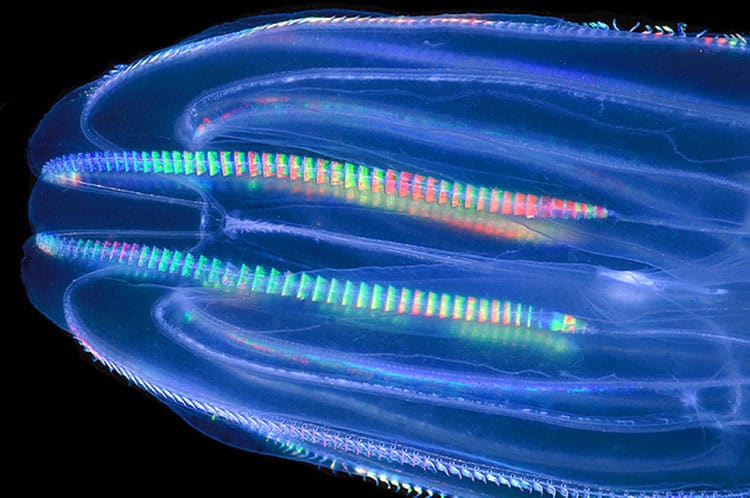• by Dr. Sarah Oktay, Director, University of Massachusetts Nantucket Field Station •

Bioluminescence is the creation of light by a chemical reaction by a creature. One of the many benefits of living on Nantucket is that we get to experience bioluminescence from many sources, not the least of which is our aquatic pals in the harbor and Nantucket Sound and the surrounding Atlantic Ocean. Around the island, the two most typical sources of underwater pyrotechnics are comb jellies and dinoflagellates. If you see flickering underwater sparkles at a northern beach like Steps Beach, you are likely looking at a type of dinoflagellate known as “sea sparkles.” These are large (at least for a single-cell organism at 1mm) plankton-eating species of dinoflagellate called Noctiluca that can be seen scintillating in the water as bright sparks of light at night in the waves nearshore.
More commonly, and especially during a few weeks each summer, we get a HUGE bloom of Ctenophores or “comb jellies”. We will learn more about those shortly. First, let’s discuss some basics about bioluminescence. Scientists at the University of California at Santa Barbara run the “Bioluminescence Web Page” found at http://biolum.eemb.ucsb.edu/organism/ which is a compendium of all creatures that can produce light via a chemical reaction. From them we learn that bioluminescence is primarily a marine phenomenon although fireflies and click beetles and fungi like foxfire on land also have this ability. It is the primary source of light in the deep sea. Their tree of life shows the distribution of bioluminescence across taxa (various types of organisms) and it shows us this phenomenon has evolved simultaneously in many different creatures. Bioluminescence is not the same as fluorescence or phosphorescence. Chemiluminescence is a general term for production of light when the excitation energy has come from a chemical reaction (as opposed to the absorption of photons, in fluorescence). Bioluminescence is a subset of chemiluminescence, where the light-producing chemical reaction occurs inside an organism. At least two chemicals are required to create this light. The one which produces the light is generically called a “luciferin” and the one that drives or catalyzes the reaction is called a “luciferase.” Luciferase is a generic term for the class of oxidative enzymes used in bioluminescence. The name is derived from Lucifer, the root of which means “light-bearer” (lucem ferre). I would recommend the Wikipedia entry (http://en.wikipedia.org/wiki/Lucifer ) to understand the evolution of the name Lucifer, I was surprised at its convoluted past. The luciferase catalyzes the oxidation of luciferin which results in light and an inactive oxidated “oxyluciferin”. In most cases, new luciferin must be brought into the system, either through the diet or by internal synthesis. In other words, one dance partner uses oxygen to get the other one excited and the party is started, and we will leave it at that.

These little guys are delightful creatures also called “sea snot,” which will become abundantly clear if you ever try to hold one of these slippery things in your hand. There is not a child on earth who does not love these very safe creatures. They are quite beautiful in the daytime with the cilia pulsing and scattering light producing a rainbow type effect, and they are even more beautiful at night because they produce a green light via bioluminescence that causes these creatures to flash on and off when disturbed. You can see this light show on dark nights in the harbor especially near the Head of the Harbor and off Steps Beach. When we did a recent marine biology tow (end of July) our plankton net filled up with comb jellies in just a few minutes.
Nantucket’s most common comb jelly, the Leidy’s comb jelly (Mnemiopsis leidyi), starts reproducing in large numbers or “blooming” in mid-summer, usually around the beginning of July. The comb jelly is a translucent walnut-shaped body with wart-like bumps which is sometimes called a sea walnut. The Leidy’s comb jelly is native along the Atlantic seaboard from the Carolinas to Cape Cod and grows to 5 inches in length. It is a popular food item for turtles and sunfish (Mola Molas) and tuna, butterfish, and spiny dogfish. Leatherback turtles really depend on them and they are the most common turtle found in our colder waters. As some of these larger predator species populations decline, comb jellies start taking over and their numbers have been increasing over the past few years in Nantucket Harbor. This is not good news for the oyster farmers.
You can catch some in the harbor and take them a dark room and gently stir them to see their bluish green light show. This video link on YouTube one is one of the most relaxing and beautiful videos of a ctenophore that I have ever seen, I highly encourage you to check it out https://www.youtube.com/watch?v=3ytnJPfzfho. This video takes you on a deep sea dive so that you can see an amazing array of light emitting marine creatures including ctenophores http://ocean.si.edu/ocean-videos/encounters-bioluminescent-creatures.
I didn’t learn until recently that comb jellies can be a big problem for oyster larvae. Oyster larvae are a primary food source for comb jellies and according to Jack Cover, the Curator at the National Aquarium (http://www.aqua.org/explore/animals/jellyfish-leidys-comb-jelly): “In addition to over-harvesting, comb jellies have been blamed for the decline of the once-over-abundant Virginia oyster in the Chesapeake Bay. The free-swimming oyster larvae hatch at the same time of year that the comb jellies flourish, so oyster numbers are reduced as comb jellies feast on their eggs and larvae. Thankfully, Atlantic sea nettles consume comb jellies in some Bay tributaries, giving oyster populations a chance.”

While looking up information on ctenophores for this column I found the web site Jellywatch (like Baywatch but even more jiggling) on line at Jellywatch.org where citizen scientists can list their encounters with comb jellies, bioluminescent plankton and the many types of jellyfish out there. At the end of July, on the 28th, someone listed Steps Beach as a hotspot for comb jellies and dinoflagellates.
If you want to read more about Jellyfish I have written about them three times in this column and you can find those at http://yesterdaysisland.com/2008/features/18c.php and http://yesterdaysisland.com/tag/jellyfish/
And I’d like to throw out this link to Chris van der Wolk who may have run into this new invasive clinging jellyfish (sounds great huh?!) last week in Madaket Harbor. http://www.whoi.edu/oceanus/viewArticle.do?id=185270 a new thing for our waters and hopefully not a long term issue.


